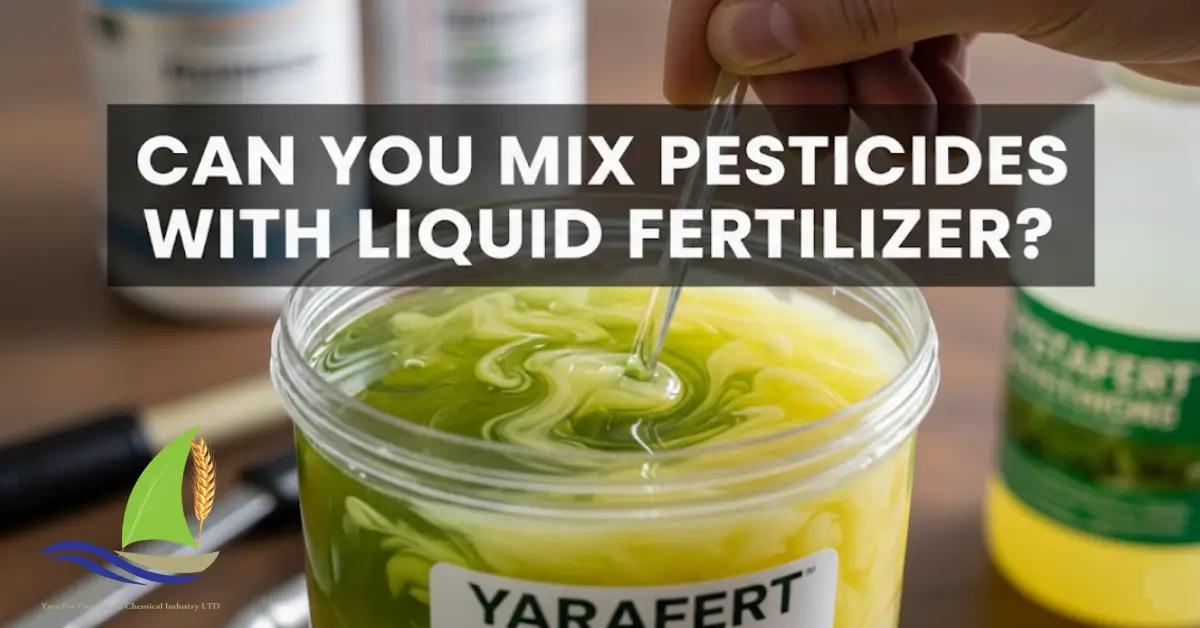Farmers and gardeners alike often ask: can pesticides be mixed with liquid fertilizer in one application? The answer is not always straightforward. While mixing these solutions can save time and improve efficiency, it also carries risks of incompatibility, reduced effectiveness, and even crop injury. This guide explores the relationship between liquid fertilizer and pesticide tank mixes, providing best practices, scientific insights, and product-based recommendations.
Compatibility of Pesticides and Liquid Fertilizers in One Application
The first question to ask before tank mixing is whether the pesticide’s chemistry is compatible with your chosen liquid fertilizer. Some fertilizers, such as Yarafert’s Biofast (rich in nitrogen, phosphorus, potassium, humic acid, and fulvic acid), contain organic compounds that may interact with certain pesticides, altering their solubility or uptake.
Compatibility depends on factors such as:
- pH of the solution: Acidic fertilizers like Phosphoric Acid 85% w/v (pH ~1.5) can destabilize alkaline pesticides.
- Salt concentration: Products like Ugarit K-T-S 70 with high potassium and sulfur may reduce pesticide solubility.
- Micronutrients: Chelated metals in SULFOMIX (iron, zinc, copper, manganese) can bind with pesticide active ingredients.



Before mixing, it’s essential to consult product labels and perform a jar test (covered below).
Pros and Cons of Tank Mixing Liquid Fertilizer With Pest Control Products
Mixing liquid fertilizer and pesticides can offer benefits, but it also has drawbacks. Understanding both sides helps growers make informed decisions.
Advantages:
- Efficiency: One pass across the field reduces fuel and labor costs.
- Dual action: Fertilizer improves plant vigor, while pesticides protect against pests.
- Synergistic uptake: Solutions like CALCIMAG (N, Ca, Mg, B) can improve nutrient absorption while strengthening cell walls, enhancing plant resilience against pest damage.
Disadvantages:
- Chemical incompatibility: Some mixtures form precipitates, clogging sprayers.
- Reduced efficacy: Pesticide activity can be neutralized by certain nutrient salts.
- Crop injury risks: High-nutrient solutions like SULPHOMIN (45% N, 15% sulfur) may cause phytotoxicity when combined with sensitive pesticides.


How to Perform a Jar Test Before Mixing Liquid Fertilizer With Pesticides

The jar test is a simple, essential step before tank mixing. It simulates compatibility on a small scale before risking a full spray application.
Steps for a Jar Test:
- Fill a clean jar halfway with water.
- Add the liquid fertilizer (e.g., Ugarit Multi with potassium, sulfur, and calcium).
- Add the pesticide at the recommended dilution.
- Shake well and let the solution rest for 15–30 minutes.
- Observe for signs of separation, clumping, foaming, or precipitation.
If the mixture remains stable, it is generally safe to use. If not, avoid combining the products in the tank.
Timing Tips for Applying Liquid Fertilizer Alongside Pest Treatments
Even when products are compatible, timing matters. Applying fertilizers and pesticides simultaneously can sometimes reduce effectiveness.
Best practices for timing applications:

- Apply nitrogen-rich fertilizers like Ugarit Cereal (15% N + Cu) early in growth stages, when plants need rapid vegetative development.
- Schedule systemic pesticides during periods of active plant growth for maximum uptake.
- Avoid mixing high-concentration phosphorus solutions like Ugarit 10-65-10 with foliar-applied insecticides during flowering, as this may increase burn risks.
- Consider alternating days: apply liquid fertilizer first, then pesticides 2–3 days later, especially when working with sensitive crops like strawberries and grapes.
Label Warnings to Watch When Mixing Liquid Fertilizer and Chemicals

Every pesticide and fertilizer label provides critical instructions on tank mixing. Ignoring these can lead to ineffective sprays or crop injury.
Key label warnings include:
- Mixing restrictions: Some pesticides explicitly prohibit combining with fertilizers.
- pH guidelines: Products like Phosphoric Acid 85% may require buffering agents before safe mixing.
- Application rates: Over-application of concentrated fertilizers like Ugarit DKP (33% P?O?, 44% K?O) may amplify pesticide toxicity.
- Crop-specific cautions: Labels often specify which crops can safely handle tank mixes.
Technical Insight: Nutrient-Pesticide Interactions
When evaluating liquid fertilizer and pesticide combinations, it’s useful to understand the chemistry at play:
| Fertilizer Component | Potential Pesticide Interaction |
|---|---|
| Nitrogen (N) | May increase foliar uptake but risk leaf burn with oils |
| Potassium (K?O) | Usually safe, but high salts can reduce solubility of EC pesticides |
| Phosphorus (P?O?) | Acidic; may destabilize alkaline pesticides |
| Micronutrients (Zn, Cu, Fe, Mn) | Chelates may bind pesticide actives, reducing efficacy |
| Humic/Fulvic acids | Can act as adjuvants, improving systemic absorption |
Conclusion: Making Safe and Effective Tank Mixes
Mixing pesticides with liquid fertilizer can be a smart way to optimize efficiency, but it requires careful attention to compatibility, timing, and label instructions. Yarafert’s range of solutions—from balanced blends like Biofast to specialized options like SULFOMIX and CALCIMAG—offer flexibility to meet crop needs while maintaining safety in tank mixes.
Next Steps:
- Perform a jar test before every new tank mix.
- Consult product labels and agronomists for compatibility guidance.
- Explore Yarafert’s portfolio of liquid fertilizers designed to integrate smoothly into modern crop protection programs.
? Contact our team today to learn which Yarafert solution best supports your pest management strategy, or visit our website to explore product options tailored to your crops.

